
loaded:/images/placeholder.png
loaded:/images/placeholder.png
loaded:/images/placeholder.png
loaded:/images/placeholder.png
loaded:/images/placeholder.png
Street art: 10 must-see murals in Tallinn
11.03.2021
Mairit
Krabbi
Do you enjoy quality street art, or are you simply looking for a suitable background for your next viral social media post? Take a walk along the streets of Tallinn and spot the most popular murals in the Estonian capital! You can see some of the best street art in Telliskivi Creative City, but exciting works can also be found on buildings in other areas of Tallinn.
Here are some of the most loved urban murals in Tallinn, listed according to their popularity on Instagram, Facebook, and various other media platforms.
1. Kalevipoeg’s First Flight, Cinzah 2017
Kalevipoeg's First Flight is a colourful mural that greets those arriving from the Balti jaam railway station. Due to its size, it is almost impossible not to notice it, not to mention that the giant white-tailed eagle covering the entire wall is also beautiful and eye-catching.
Eagles are a symbol of leadership, strength, and vision, and many cultures see them as messengers. The work got its name from the Estonian national epic, where Kalevipoeg flew to Estonia on a majestic eagle. The mural aims to inspire viewers to think about their relationship with the environment, how can they influence their surroundings, and connect with the old world.
Cinzah completed the mural in 2017 within the framework of the Mextonia Street Art Festival. Cinzah is a street artist from New Zealand who focuses on environmental issues and storytelling.
Address: Reisijate 7 (Telliskivi Loomelinnak)
Nearest public transport stops: Balti jaam (trams No. 1 and 2), Tallinn (train)

2. Ülemiste Girl, Von Bomb 2015
"Ülemiste girl" is the largest mural in Estonia and the Baltic region. The colourful large-scale image of a young girl holding a red umbrella with blue sky and raindrops in the background was one of the first murals in Tallinn and received a lot of attention and media coverage.
If you look closely, you can see that the drops are, in fact, a binary code consisting of 1,560 ones and zeros. From these numbers, it is possible to decode Debora Vaarandi's poem Oldy of Ülemiste and young city builder. The binary code fits well with the image of Ülemiste City – it is home to several startups and IT-companies.
The work was completed in 2015 on the wall of an old factory building. The author of the work is Indrek Haas, an Estonian stencil artist known as Von Bomb. He mainly uses stencil techniques, and his creations are inspired by street and pop art. Edgar Tedresaar, Martin Urb, Paavo Kuldkepp, Taavi Kask, and Alar Tuul also contributed to completing this impressive mural.
Address: Suur-Sõjamäe 12a (Ülemiste City)
Closest public transport stop: Dvigatel (buses No. 7, 15, 45, 49, and 65)
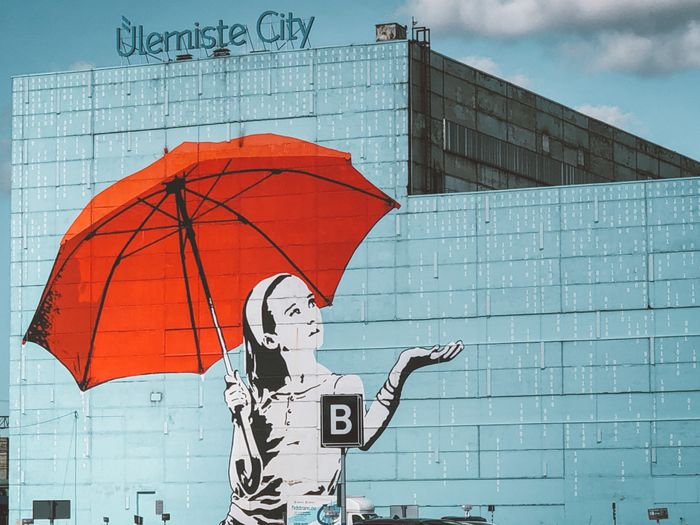
3. Keep white wishes in your black box, Izak 2015
"Keep white wishes in your black box" is every animal lover's favourite mural! Its attractive pinkish-purple background attracts attention from afar, and the giant sphinx cat is very lifelike. There are fish skeletons above the cat, probably eaten before.
Sphinx cats symbolise a youthful soul and body and the fact that everyone can make what they want out of their lives. The idea of the work itself, however, is to think good thoughts even in bad times. True to its title, the mural depicts a black box above the cat's head, from which white wishes come out - in the cat's case, white fish skeletons.
Izak, a street artist from Chile, completed the mural on the façade of the Kivi Paber Käärid restaurant in 2015 as part of the Street art jam x JJ-Street Baltic Session festival. Izak is known for drawing something on the wall on his every trip: you can find his work in Argentina, Peru, Latvia, Finland, Greece, and several other countries.
Address: Telliskivi 60a/8 (Telliskivi Loomelinnak)
Nearest public transport stops: Telliskivi (trams No. 1 and 2), Tallinn (train)
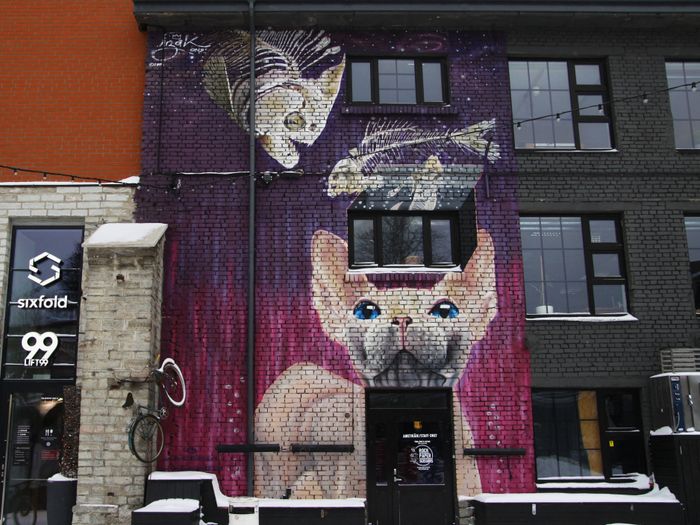
4. Dance of Death with Endel aka Endel with a stick, Edward von Lõngus 2017
"Dance of Death with Endel, aka Endel with a stick" is a stencil graffiti on a brick surface. The mural depicts a hipster taking a selfie with a skeleton. The title is a wordplay in Estonian, Endel being both a traditional (yet slightly old-fashioned) male name and slang for selfie.
The work depicts a happy man who wants to take a picture with Death. It refers to hipster culture and self-exposure in modern cultural space. The picture is in black and white, as the contrast has a strong and direct effect on the viewer.
The mural's story is interesting: one night in 2017, the graffiti appeared on a building to be demolished on the next day, but fortunately, part of the wall was spared to save the artwork. One of the reasons behind the mural's survival is its author: Edward von Lõngus is one of Estonia's most famous street artists.
Operating anonymously since 2008, Edward von Lõngus has also been called the Estonian Banksy, one of the most famous street artists in the world. Edward's creations can be found in Estonia and all over Europe – in Paris, London, Berlin, Budapest, and other cities.
Address: Telliskivi 60a (Telliskivi Loomelinnak)
Nearest public transport stops: Telliskivi (trams No. 1 and 2), Tallinn (train)
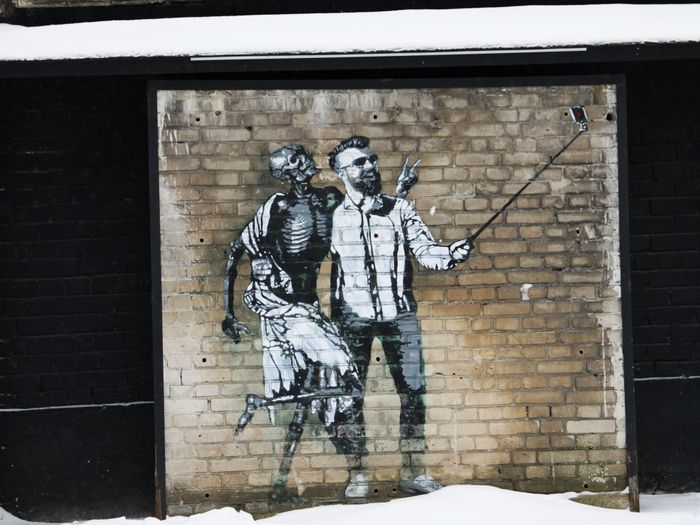
5. Forest Spirit, Goal 2017
"Forest Spirit" is a mural depicting a wild boar with other wild animals on its back – a bear, an elk, and a wolf. The work has a pretty dark tone, but the subject matter still feels surprisingly homelike and familiar. The fact that the boar's eyes are not drawn and are entirely white also adds to the mystery.
The work symbolises the nature around us as a world full of magic and mysticism. All the animals depicted on the boar's back have been important to Estonians for centuries. The bear was a sacred animal for a long time and has had several nicknames. Elk, in their turn, were thought to be able to tell the weather. And the wolf, according to legend, was created by the Old devil himself. Wild boars, on the other hand, have been considered a foreign species by Estonians.
The work was completed in 2017 within the framework of the Mextonia Street Art Festival. The author of the painting is an artist named Goal.
Address: Tartu maantee 13 (Kesklinn)
Nearest public transport stops: Paberi (trams No. 2 and 4), Tornimäe (buses No. 2 and 15)
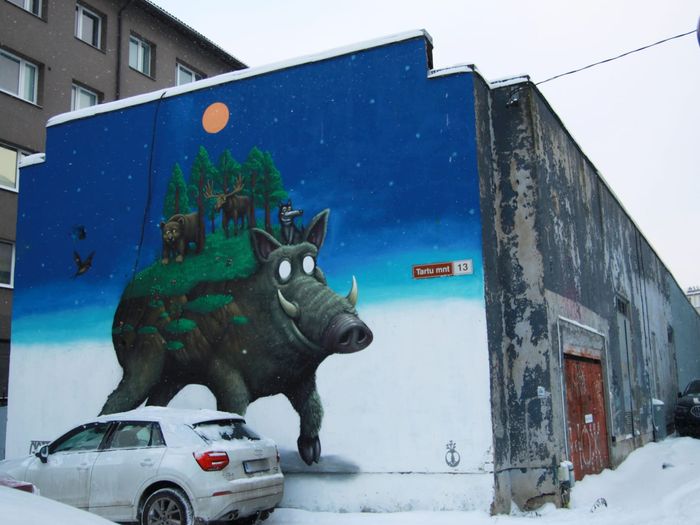
6. Dusk and Dawn, Reyben 2017
The small and humble building next to Telia's head office is decorated with various murals. On one side, you can see a wolf's head, surrounded by different patterns. Interestingly, the wolf's eyes are painted in two different colours, probably related to the work's idea and symbolism.
It is a work inspired by "Dusk and Dawn", a story about the yearly meeting of two lovers on Midsummer Night, which results in a new life. The shades of orange indicate the sunrise, and the bluish tones symbolise the darkening of the evening.
The work was completed in 2017 within the framework of the Mextonia Street Art Festival. Its author is Reyben, a Mexican artist who mainly uses the stencil technique. In his works, he depicts societal issues and problems.
Address: Mustamäe tee 5i (Kristiine)
Closest public transport stop: Hipodroom (buses No. 16, 21, 21B, 42, and 47)
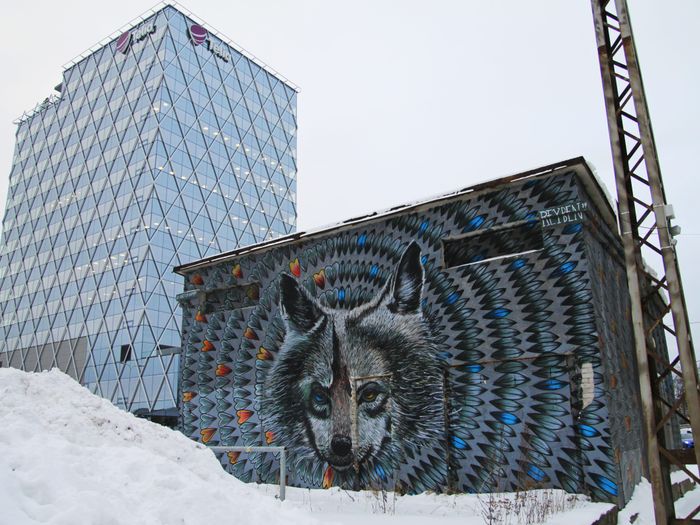
7. Blue Deer, Sänk 2017
"Blue Deer" was created within the framework of Mextonia Festival. It illustrates the joint symbolism of two countries, Estonia and Mexico. Although it is difficult to notice this work on a small wall behind the trees, the enchanting life-size deer is definitely worth looking for.
The Mexican symbolism is based on the ancient tribe of Huichol, who hunted blue deer to find wisdom and introspection. Estonians, on their side, traditionally hunt for a fern flower, a magical plant blooming only on Midsummer Night. The fantastical elements of both countries are associated with prosperity, protection, and fertility.
Sänk, an Estonian street artist and art teacher from the region of Võru, completed the painting in 2017.
Address: Telliskivi 60a (Telliskivi Loomelinnak)
Closest public transport stop: Telliskivi (trams No. 1 and 2)
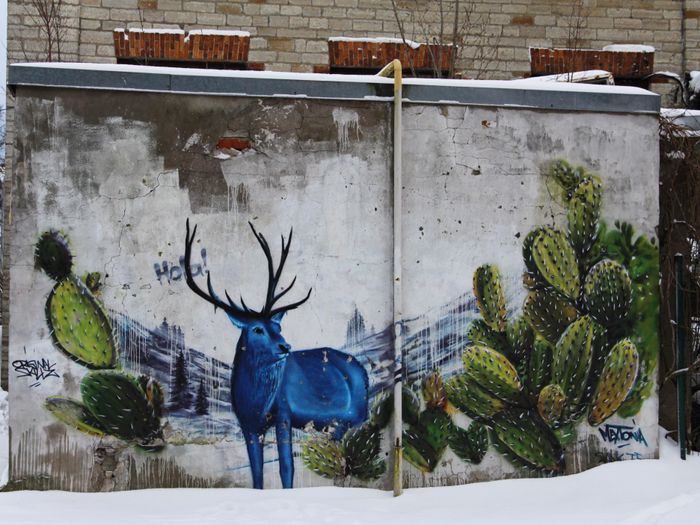
8. Woman, Hopare 2014
This eye-catching work depicts a woman covered with various coloured lines and shapes. The building's dark background makes the painting effective, allowing the piece to come to the fore. The work was completed in 2014 as part of the Street Art Jam series, which featured artists worldwide showcasing quality street art and graffiti.
Interestingly, the woman on the wall represents an actual person living in Tallinn who the artist met by accident while walking on the street. She inspired the artist so much that he decided to draw her face on the wall.
The author of the mural is Alexandre Monteiro from France, known as Hopare. His work is always related to a chance encounter, a place, or a specific event.
Address: Telliskivi 60a/6 (Telliskivi Loomelinnak)
Nearest public transport stops: Telliskivi (trams No. 1 and 2), Tallinn (train)
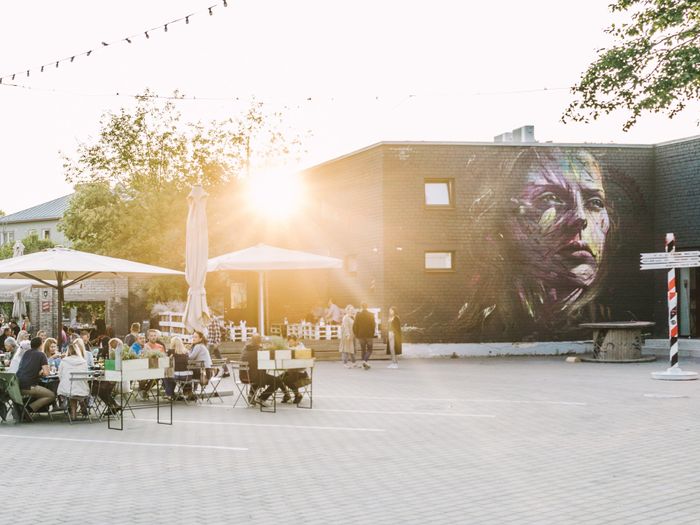
9. Jõuvanker, Edgar Tedresaar 2019
"Jõuvanker" ('carriage of power' in Estonian) is inspired by one scene from the 2019 film Truth and Justice. The work depicts a man named Pearu on a carriage drawn by a horse. The colourful mural stands out from the old apartment building facades in the vicinity.
The author has described his idea as follows: 'In the old days, every man had his own carriage. Now, almost every household has its personal carriage to ride around the city. The speeds have changed, and the man riding in a carriage is far behind us.' Thus, the work is, in its way, a comparison between the present and the past.
The author of the mural is Edgar Tedresaar, an Estonian painter and a member of the art group Piiritus. Paavo Kuldkepp, Katre Salu, and Ahto Eller also contributed to the completion of the work.
Address: Keldrimäe 2 (Kesklinn)
Closest public transport stop: Püssirohu (buses No. 17, 17A, 23, 47, and 54)
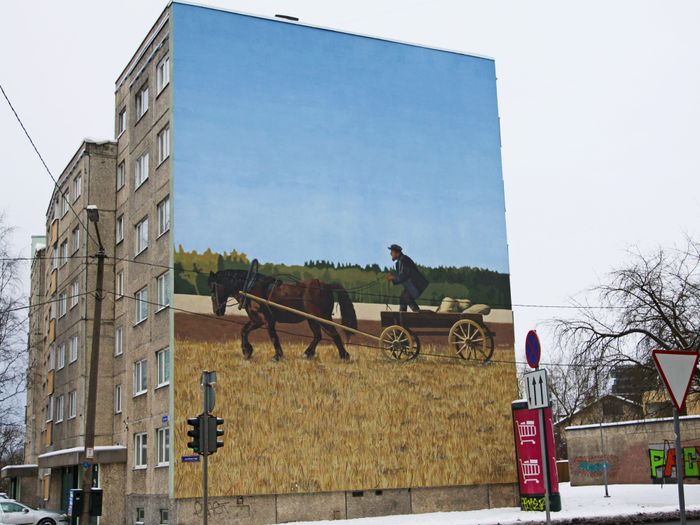
10. F.R. Kreutzwald, Robot Muralist 2020
Walking along Telliskivi Street, you can discover one of the most famous Estonian writers – Friedrich Reinhold Kreutzwald – on the wall of one of the houses. The picture gives a warm feeling and looks like an ordinary oil painting.
The inspiration for the work came from an oil painting by Lola Liivat-Makarova, which depicts a writer preparing to write a book. The upper part of the mural represents Kreutzwald, and the lower part contains a locally well-known excerpt from the national epic Kalevipoeg. However, the sentence has been modernised and made telephone-centric, i.e. instead of a kannel (a traditional musical instrument), the writer wants to borrow a phone and high-speed internet.
The author of the work is Robot Muralist, who is actually two robots named Leonardo and Albert. Leonardo is a handheld robot, and Albert can climb on the wall by itself to create something new and beautiful. The creative device has won awards at local startup competitions. The mural was completed in 2020.
Address: Telliskivi 60a (Telliskivi Loomelinnak)
Closest public transport stop: Telliskivi (trams No. 1 and 2)
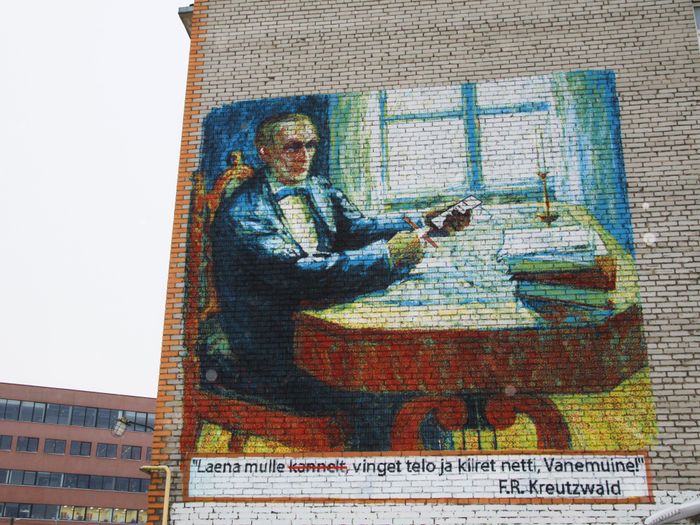
The database of Tallinn street art, compiled by Reigo Tori, was used in writing the article.









